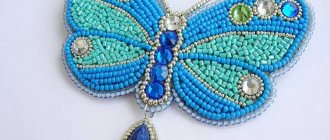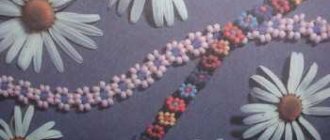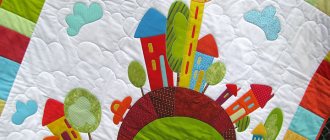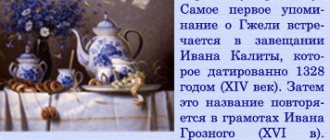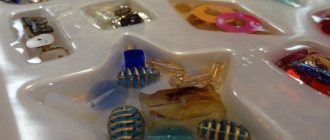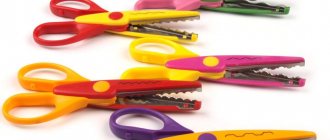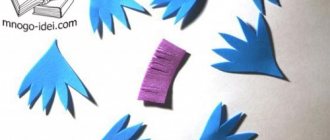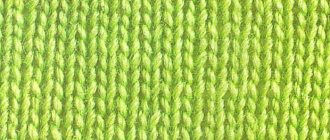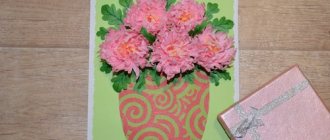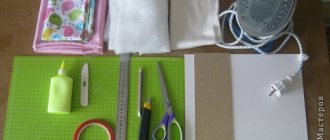DIY patchwork blanket made from squares
For sewing you will need:
- squares of cotton fabrics, different colors, 25 cm by 25 cm – 20 pcs.;
- padding or fleece - 105 cm by 130 cm;
- fabric for the wrong side – 105 cm by 130 cm;
- threads, sewing tools.
How to sew a blanket
To sew a patchwork quilt with your own hands, we prepare the required number of square patches.
Then we lay out 4 squares. for 5 pieces, combining them by color.
Let's start sewing a blanket from multi-colored scraps with our own hands by making horizontal stripes. To do this, fold the squares in pairs with their right sides facing each other. First we will sew the sides of each pair on the right side of the stack, then we will have to sew the squares on the other side.
We continue patchwork sewing by stitching together the finished strips. One common part is sewn from them. The technique for assembling a patchwork quilt is as follows: fold the strips right sides together, pin them together, paying attention to the coincidence of the lines of the transverse stitching seams.
We combine the stripes into a common fabric.
Iron all seams.
From the sealant we cut out a rectangular piece, equal in size to the patchwork piece. We place the seal on a horizontal, flat surface, and place the patchwork piece on top, face up.
We cut out the blank for the bottom part of the bedspread and place it on the laid out parts of the seal and top, face down. We chop off a three-layer “sandwich” and stitch it, leaving an open area.
Trim off the excess seam allowance and turn it inside out.
Carefully straighten the seams, paying special attention to the corners, and iron the product. In this case, we turn the allowances in the open area inward. We sew up the open area using a machine, although you can sew it manually with blind stitches.
The blanket is voluminous and warm. Given the multi-layer nature, it is recommended to quilt all patchwork bedspreads. Let's do this with a regular simple line. We perform it in the seams of sewing flaps.
The voluminous bedspread is ready!
Creating a Layout
After the dimensions of the finished product have been determined and the number of elements has been calculated, it is necessary to determine the principle of their arrangement.
From 3 to 9 or more different patterns (colors) are used. Traditional aesthetics rarely use plain, unpatterned patches. But you can introduce one monochrome fabric, use it for edging and as one of the elements of the main pattern.
It is not customary to add fabrics of different colors with the same pattern to the palette.
The principle of randomness in the arrangement of fragments is the main feature of patchwork products, which arose at the early stage of this style, when work on the blanket lasted many years.
The beauty of a homemade quilt largely depends on a thoughtful sewing pattern. There are no specific rules for repeatability; you can use an equal number of squares of each type, or choose some fabrics that will be repeated more often than others. This freedom allows you to create variants for already prepared material.
In any case, you will need a scaled layout of the front layer; in the case of squares, it will be a grid, each cell of which is indicated by a number, or, for greater clarity, painted over with a similar color. Identical parts can be arranged symmetrically, in the form of a diamond, a cross, a diagonal line, or in a random order.
For even distribution, you can create a repeat using all the fabrics. For example, lay out a 3 by 3 square using 9 different fabrics, and repeat this arrangement over the entire area of the product.
To emphasize variety, patches with asymmetrical patterns or striped fabrics are placed in different positions, with turns of 90 or 180 degrees.
If you are planning a large product with small details, you can assemble more complex geometric patterns using pixel patterns, using both squares and triangles.
DIY patchwork bedspread
To sew a patchwork bedspread you will need:
- multi-colored rags 6.25 cm by 11.25 cm – 160 pcs.;
- two pieces of plain fabric (light and dark) – 120 cm;
- fabric for border – 45 cm;
- batting or other insulation 1.3 m by 1.4 m;
- fabric for lining – 1.3 m by 1.4 m;
- threads, sewing tools.
Step-by-step sewing instructions and photo master class
To make a blanket from multi-colored rags with your own hands, cut a light plain fabric into nine strips 6.25 cm wide. Then we divide each strip into rags 11.25 cm long. A total of 80 light rags are needed.
Using a similar technology, we cut dark fabric, obtaining 80 flaps measuring 6.25 cm by 11.25 cm.
For the border we prepare 5 strips of 5.6 cm each.
We fold the printed and plain flaps in pairs with their front sides facing each other, and sew them along the long sides. We get square blanks 11.25 cm by 11.25 cm, since part of the double width will go to seam allowances.
We lay out the blanks, orienting their seams perpendicular to each other.
When making a patchwork mosaic strip, we alternate two blanks with a light border with two blanks with a dark one. Each strip must consist of 12 squares.
When combining the flaps for the second strip, we lay the first square so that its stitching seam is perpendicular to the stitching seam of the first square of the first strip - see photo.
A completely hand-made patchwork blanket consists of 13 stripes, 12 squares each.
To ensure that a hand-sewn patchwork blanket is not only beautiful, but also warm, we use a batting pad.
We lay the material for the lining on the floor with the wrong side up, put insulation on top, and place the patchwork piece on top of it with the right side up. We cut off three layers.
We quilt the bedspread using any type of stitch.
For the border, we sew strips 5.6 cm wide into one piece and press the seams. Fold the border in half, inside out, and iron. Then we fold the cuts of both sides towards the center and iron them.
We trim the sections of the bedspread, cutting off irregularities and excess insulation. We process the perimeter of the bedspread with a border.
Children's patchwork quilt with trapunto embroidery
Dimensions of the finished product are 125 x 125 cm.
What you need to prepare:
- dark fabric with a small print, with a width of 1.1 m you need to take 0.5 m;
- the fabric is light, plain, with a width of 1.1 m you need to take 0.5 m;
- fabric that combines the color scheme with the previous ones, with a “peas” pattern, with a width of 1.1 m you need to take 0.7 m;
- fabric that matches the color of the underside of the blanket;
- fabric for bias tape or finished tape;
- filler;
- threads, sewing tools.
How to sew a patchwork quilt
We sew a patchwork quilt from square blocks, sewn, in turn, from rectangular and square parts.
We will combine the patchwork components according to the Irish square pattern. It is practical and versatile, easily converted to the required size of the blanket. A chain made up of squares can be single, double or triple. It depends on your choice. Embroidery or applique will look great on free areas.
The composition of the Irish square is harmoniously combined with other types of patchwork techniques and is easy to implement. This is an ideal option for beginners.
This blanket does not require a duvet cover; it can be used as a bedspread.
For convenience, the fabrics used in cutting are indicated in the photo with letters.
We cut strips of four types of fabric in width:
- plain (C) – eight stripes 16.5 cm by 27 cm;
- polka dots (B) – five stripes 16.5 cm by 27 cm;
- The rest of the fabric is cut into strips 6 cm wide.
Each block is a square with a side of 20 cm. It includes five strips of squares with a side of 5 cm. Seam allowances must be added to this size. When using a quilting foot, an allowance of 7-8 mm per side is sufficient. Accordingly, the side size of the square workpiece is 6.5 cm.
We sew the strips in the sequence C – A – B – A – C.
Then from the sewn wide strip we cut strips 6.5 cm wide.
Sew the cut out strips so that the dark squares are arranged in a checkerboard pattern.
We must prepare 12 identical square blocks.
The second type of square blocks is sewn from fabrics A and B. From fabric B, we cut out one rectangle 15 cm by 25 cm, two rectangles 5 cm by 15 cm. From fabric A we prepare four squares with a side of 5 cm. Do not forget to add seam allowances 7-8 mm each. Sew the squares together as shown in the photo.
Similar blocks in the amount of 8 pcs. sew from fabrics B and C.
We make four more blocks from fabrics A and B, almost as described above, but we place dark squares only in three corners of the element.
From the prepared square blocks we assemble the upper part of the bedspread, guided by the photo. First we connect the horizontal stripes, then we sew them vertically.
How to do embroidery
This master class uses two patterns made with straight stitches. Such patterns are best suited for embroidery using the trapunto technique. This is voluminous embroidery that requires certain skills. For craftswomen who have not previously encountered this type of needlework, it is advisable to study it first.
To complete the work, in addition to the stitched patchwork fabric, we will need a sealant and a tear-off non-adhesive stabilizer.
On each square block where embroidery will be done, we find the center point. We thread the tear-off non-adhesive stabilizer into the hoop and apply a layer of glue to it. If your cushioning layer is made of fleecy fabric, then there is no need to apply a layer of glue.
We glue the cushioning material onto the stabilizer and place a square patchwork block on top of it. In this case, it is important to orient the area for embroidery in the center of the hoop.
We fix the patchwork square with pins. Embroider the selected fragment. We embroider similarly on the remaining patchwork blocks.
Assembly
Carefully trim the filling around the embroidered fragments at a distance of 5 mm from the seam. We pin together the layers of the blanket with pins. We sew the blanket using a walking foot along the perimeter and diagonally.
Free motion stitch
We quilt the squares with central fragments of fabric B using a free-running stitch, making a “brains” pattern. You can also hand stitch along the contour of the embroidery at a distance of 5 mm from it. If you want to add extra volume to your embroidery, use microstitching.
Processing the edges of the bedspread
We prepare the bias tape and process the edge of the product either by machine or by hand.
The bedspread is ready!
Assembly and edging
The instructions for sewing a classic patchwork quilt assume the presence of padding polyester or other filler. After stitching the patchwork layer is completed, the joining seams need to be ironed from the inside out, opening the edges, then press the joints again with an iron from the front side.
The lining is secured along one side with the front part, then the filling is lined, all three layers are leveled from the center, stitched around the perimeter and secured with pins over the entire surface.
Curtains for the kitchen - 120 real photos of new designs. Options for the ideal combination of modern curtains in the kitchen interior- How to diversify your home interior: DIY decor and beautiful design ideas
- How to hang curtains - step-by-step instructions with photo examples and recommendations. Exclusive curtain design solutions from experienced craftswomen
The border can be made by folding the edges of the backing onto the front surface, while the seam is masked with braid. Another option is strips of another suitable fabric that form a frame for the patchwork. You can choose another model: the entire front surface is divided into squares (triangles), which are adjacent to the edges.
The final stage of the master class is tamping, which is done on a typewriter, or, in the absence of technical capabilities, by hand. Through stitches cover all seams; additional diagonal lines are made to add volume.
To make the assembly process easier, you can abandon the insulation and make a two-layer version, increasing the thickness of the blanket due to denser fabric for the backing.
